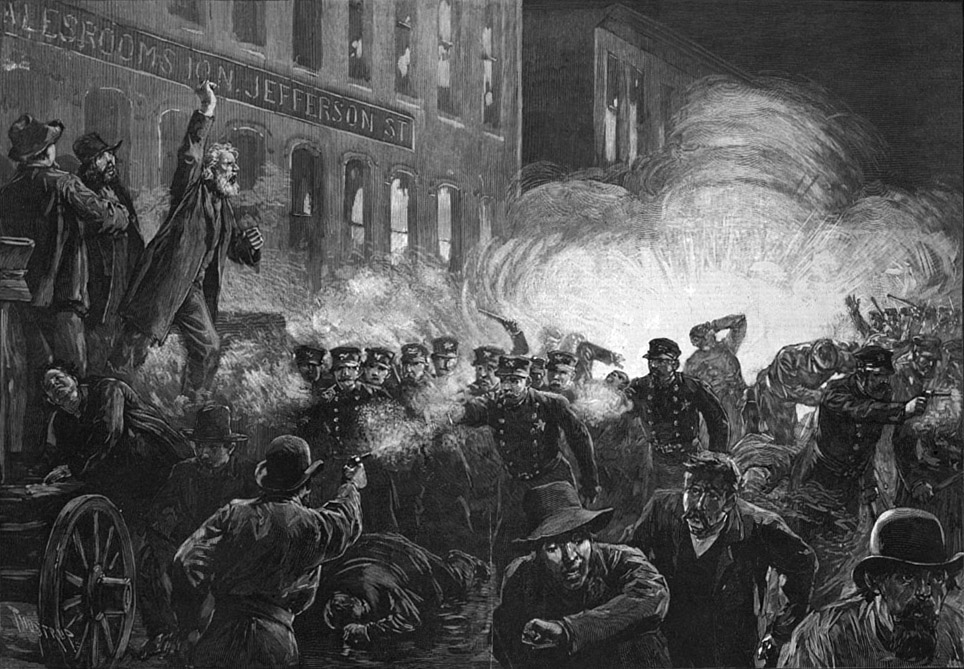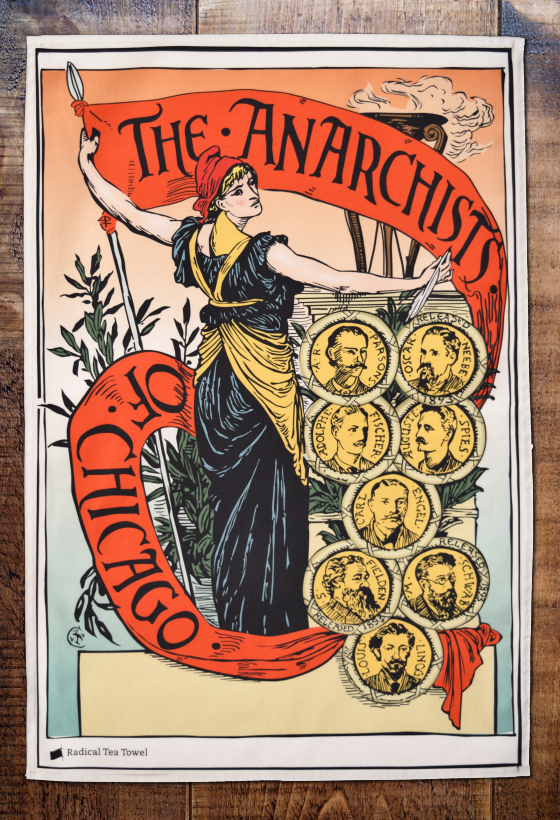Changing the Face of the Workers' Movement: The Haymarket Affair
Posted by Pete on Nov 30th 2018

I've said it before and I'll say it again: there's something in the water in Chicago.
For about 150 years, the city's been a non-stop carnival of American radical politics.
Previously, I've written for Radical Tea Towel about Jane Addams and Emma Goldman - two extraordinary (and tea towel starring) women, whose very different versions of progressive politics were both formed and practiced in the 'Windy City'.
But today's a day for some guys - eight of them, to be exact - who are stamped on Chicago's radical consciousness like no others: the Haymarket Eight.

A workers strike
It's the spring of 1886 in the United States. Capitalism is riding high over a fast-industrializing nation - but it's not yet victorious. A mass, working-class movement for an eight hour workday - the movement which made May Day into a socialist ritual - was gathering speed.
On 1st May 1886, the American Federation of Labor put out a bold call for nationwide strikes wherever the eight hour day hadn't been introduced.
Chicago was one such place. 40,000 workers went on strike in the city. Every railroad in town was put out of action.
Fearing their class interests were in danger, businessmen came together to form a 'Citizens' Committee', backed by the state.
Part of their effort was to bring in strike-breakers, behind police violence, to keep their industries going without having to concede to a shorter working day.
On 3rd May 1886, striking workers of the McCormick Harvester Works and their allies in the wider community tried to prevent these breakers getting through the factory gates.
Policemen were there, serving as the defense force of Chicago big business. They opened fire on the strikers. Four were shot and killed.
These murders would not be taken quietly by the workers.
The Haymarket Riots begin
August Spies, an anarchist leader in the city (these were the decades when anarchism was one of the main ideologies flowing through the US labor movement), immediately called for a protest demonstration - it was to take place on Haymarket Square.
3,000 workers showed up for the protest the next day.
The police were unrepentant for the actions of their colleagues at the McCormick Factory. They advanced on the podium, guns loaded, and ordered the crowd to disperse.
At that moment a bomb went off among the police - killing seven and wounding 66. They immediately opened fire on the overwhelmingly unarmed crowd of workers, killing several and wounding around 200.
It's never been established who threw the bomb - there are claims it was a police agent among the anarchists, Rudolph Schnaubelt, creating a pretext for what happened next.
The murder of the Haymarket Eight
Following the events at Haymarket, eight Chicago anarchist leaders were arrested for the attack on the policemen. It was an absurd move by the authorities. Everyone knew that none of these men had thrown the bomb - only one of them had actually been at Haymarket when it happened!
But under 1880s Illinois law, incitement to murder was equivalent to murder itself, and some contemporary anarchist rhetoric about 'class war' supposedly amounted to such incitement.
But far more important than Illinois law was the Illinois elite's wish to hit out at these troublesome working class firebrands.
Everyone knew this was what was happening - the courts were being used to murder these eight men for their left-wing politics.
The outrage was worldwide. And so was the solidarity.
In London, England, there was a meeting organized by socialists George Bernard Shaw and William Morris for the 'Haymarket Eight'. Shaw, following the rejection of the anarchists' appeal against their death sentences, remarked caustically "If the world must lose eight of its people, it can better afford to lose the eight members of the Illinois Supreme Court."
A year later, in November 1887, four of the Chicago anarchists - August Spies, Albert Parsons, Adolph Fischer, and George Engel - were hanged (murdered) by the state. A fifth, Louis Lingg, committed suicide before his sentence could be carried out. He was only 21 years old.
Changing the face of workers movements
There followed mass outrage. 25,000 marched in Chicago to protest and mourn. The popular pressure was such that John Peter Altgeld, the new governor of Illinois, pardoned the three anarchists still in jail. He boldly concluded that the whole Haymarket Affair had been a terrible 'miscarriage of justice'.
Good work, Governor Atgeld. But it's worth saying the notion that this was a 'miscarriage of justice' (i.e. an anomaly) misses the point.
By 'neutralizing' a working class challenge to American capitalism, the US criminal justice system arguably functioned just as it was supposed to at Haymarket.
In other words, it's not an 'anomaly' that the Haymarket Eight were imprisoned and executed - it's a reminder.
A reminder that social justice and political progress can't be reliably found in state institutions like the judiciary or the FBI.
It's to be found instead in social movements: people creating their own spaces, objectives, and pathways independent of the channels offered by the establishment - things like the eight-hour day movement, for example.
One last thing. You might be wondering why this post is being published today, in winter, when the Haymarket Affair all went down in springtime.
Well, amid the bleakness of the story, I thought the comrades who gave their lives and freedom at Haymarket might appreciate a bit of calendar anarchism of my own...
Long may they rest in power!
